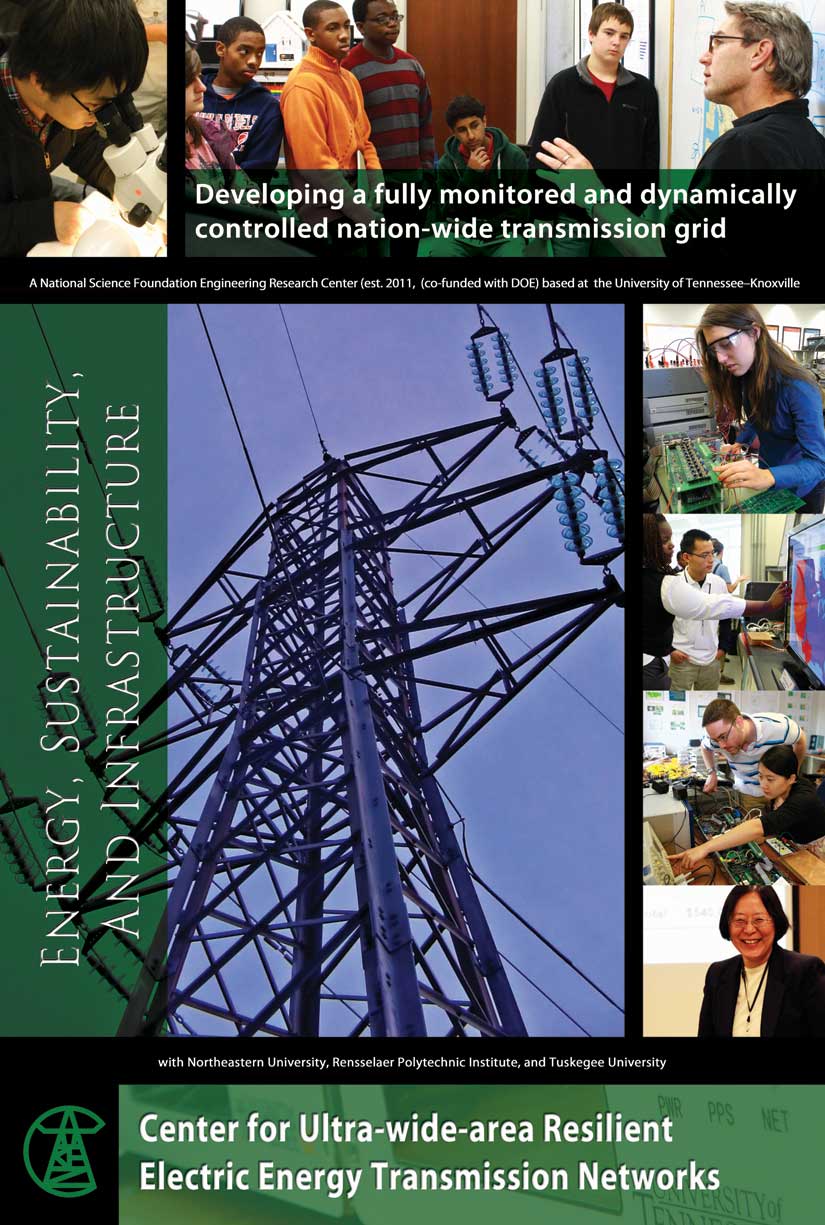ERC for Ultra-wide Area Resilient Electric Energy Transmission Networks

The Center for Ultra-wide-area Resilient Electric Energy Transmission Networks (CURENT) is a collaboration between academia, industry, and national laboratories. The Center is co-funded by NSF and the Department of Energy, Office of Electricity and Energy Reliability. The NSF-DOE collaboration allows leveraging of government funding to advance energy technology and develop innovative, globally connected engineering graduates for the energy sector with engineered systems and interdisciplinary experience. CURENT seeks to assist in the redevelopment of a nation-wide or continent-wide transmission grid that is fully monitored and dynamically controlled in real-time. The goal of this revitalization is to allow for higher reliability, greater efficiency, lower costs, better energy storage capability, and more accommodation of renewable energy sources such as solar and wind power. In short: a stronger, cheaper, cleaner, and more easily controllable way to move electricity throughout the United States. From an industrial collaboration standpoint, CURENT strives to create a culture that links engineering research to technological innovation through sustained partnerships with industryial organizations, and to stimulate technology transfer into commercial products and start-up companies. The center also develops education programs that provide multidisciplinary, team-driven, and systems-oriented opportunities to pre-college and university students, as well as to practicing engineers.
Energy and Sustainability
Energy, Sustainability, and Infrastructure
Location
Lead Institution
Start Year
Website
Fact Sheet
Core Partners
Center News and Achievements
Locations
Additional Information
Focus
CURENT is developing a nation-wide transmission grid that is fully monitored and dynamically controlled for high efficiency, high reliability, low cost, better accommodation of renewable sources, full utilization of storage, and responsive load.
Graduation Date
Education Web Page
Research Opportunities for Undergrads
Student Leadership Council
ERC for Ultra-wide Area Resilient Electric Energy Transmission Networks

The Center for Ultra-wide-area Resilient Electric Energy Transmission Networks (CURENT) is a collaboration between academia, industry, and national laboratories. The Center is co-funded by NSF and the Department of Energy, Office of Electricity and Energy Reliability. The NSF-DOE collaboration allows leveraging of government funding to advance energy technology and develop innovative, globally connected engineering graduates for the energy sector with engineered systems and interdisciplinary experience. CURENT seeks to assist in the redevelopment of a nation-wide or continent-wide transmission grid that is fully monitored and dynamically controlled in real-time. The goal of this revitalization is to allow for higher reliability, greater efficiency, lower costs, better energy storage capability, and more accommodation of renewable energy sources such as solar and wind power. In short: a stronger, cheaper, cleaner, and more easily controllable way to move electricity throughout the United States. From an industrial collaboration standpoint, CURENT strives to create a culture that links engineering research to technological innovation through sustained partnerships with industryial organizations, and to stimulate technology transfer into commercial products and start-up companies. The center also develops education programs that provide multidisciplinary, team-driven, and systems-oriented opportunities to pre-college and university students, as well as to practicing engineers.
|
LocationKnoxville, Tennessee
|
Lead InstitutionUniversity of Tennessee–Knoxville
|
Start Year |
Website |
Fact SheetDocument
|
Core PartnersNortheastern University
Rensselaer Polytechnic Institute
Tuskegee University
|
FocusCURENT is developing a nation-wide transmission grid that is fully monitored and dynamically controlled for high efficiency, high reliability, low cost, better accommodation of renewable sources, full utilization of storage, and responsive load. |
Graduation Date |
Education Web Page |
Research Opportunities for Undergrads |
Student Leadership Council |
Center News and Achievements
Locations
ERC for Ultra-wide Area Resilient Electric Energy Transmission Networks

The Center for Ultra-wide-area Resilient Electric Energy Transmission Networks (CURENT) is a collaboration between academia, industry, and national laboratories. The Center is co-funded by NSF and the Department of Energy, Office of Electricity and Energy Reliability. The NSF-DOE collaboration allows leveraging of government funding to advance energy technology and develop innovative, globally connected engineering graduates for the energy sector with engineered systems and interdisciplinary experience. CURENT seeks to assist in the redevelopment of a nation-wide or continent-wide transmission grid that is fully monitored and dynamically controlled in real-time. The goal of this revitalization is to allow for higher reliability, greater efficiency, lower costs, better energy storage capability, and more accommodation of renewable energy sources such as solar and wind power. In short: a stronger, cheaper, cleaner, and more easily controllable way to move electricity throughout the United States. From an industrial collaboration standpoint, CURENT strives to create a culture that links engineering research to technological innovation through sustained partnerships with industryial organizations, and to stimulate technology transfer into commercial products and start-up companies. The center also develops education programs that provide multidisciplinary, team-driven, and systems-oriented opportunities to pre-college and university students, as well as to practicing engineers.
Energy and Sustainability
Energy, Sustainability, and Infrastructure
Location
Lead Institution
Start Year
Website
Fact Sheet
Core Partners
Center News and Achievements
Additional Information
Focus
CURENT is developing a nation-wide transmission grid that is fully monitored and dynamically controlled for high efficiency, high reliability, low cost, better accommodation of renewable sources, full utilization of storage, and responsive load.
